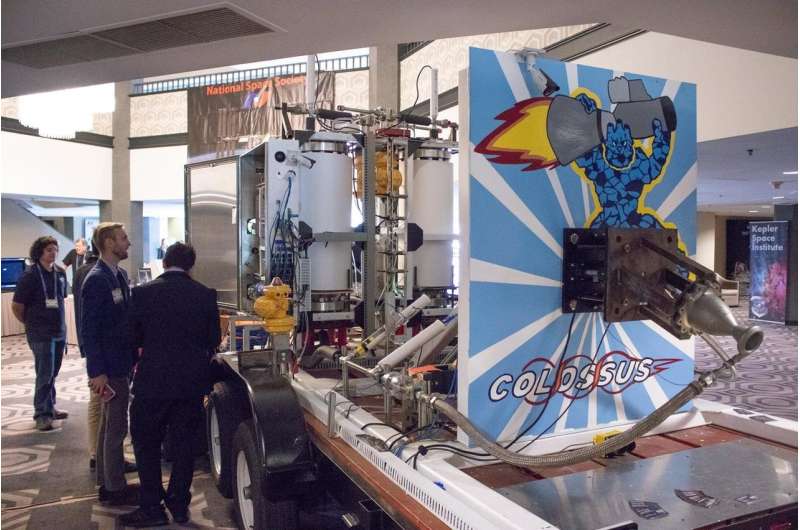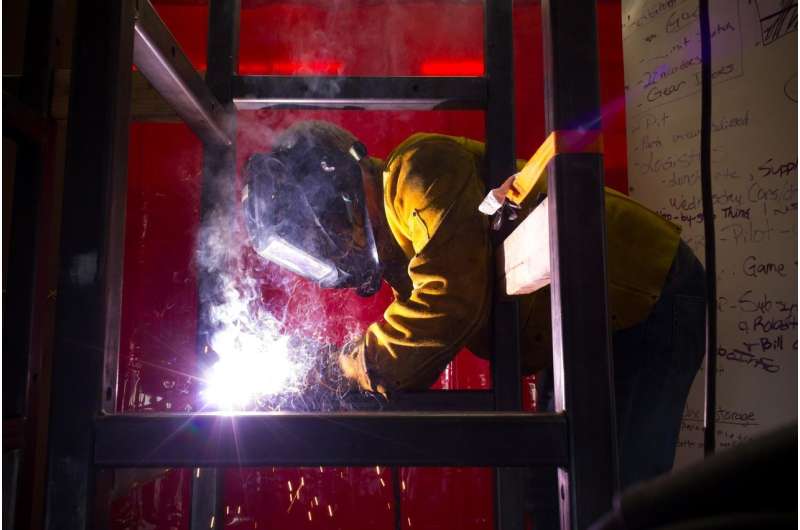Rocket development gets a 'colossal' boost

The University of California San Diego's chapter of Students for the Exploration and Development of Space (SEDS) conducted a successful live fire test of its static rocket engine test stand, Colossus, in the Mojave Desert on June 16.
The undergraduate students decided to develop Colossus when they ran into a roadblock in 2016 as they built the first rocket powered by a 3-D-printed engine: it was difficult to test the engine of the rocket in a rapid, realistic, relatively inexpensive way. They didn't want to launch the rocket, since that would mean they could no longer iterate on its design, but testing in a lab setting wouldn't provide sufficient information to ensure the engine would work as planned. What they needed was a static fire test stand that puts the engine through the full process of a launch, but while bolted to the ground.
The problem? There was only one of these rocket engine test stands available for use at an academic institution—Purdue University—but that had a long waiting list and was more expensive than the students could afford.
So, with support from NASA, they built their own.
"The big idea for this test system is to make getting to space and space research more accessible to people who don't have a massive $19 billion budget," said Jack Najarian, a third year electrical engineering student at the Jacobs School of Engineering and president of SEDS at UC San Diego.
SEDS championed and developed the static rocket engine test stand, and had a successful first live fire test at the Friends of Amateur Rocketry test site in the Mojave Desert on June 16. SEDS' own 3-D printed rocket engine, Ignus-II, was the engine tested. Ignus-II has more thrust and a more efficient cooling system than its predecessor Ignus-I, the first 3-D-printed engine launched by a student organization.
After recognizing this testing accessibility void in the market and wanting to create a system to solve their testing needs as well as those of other student groups and academic research teams, the Colossus students worked closely with NASA to define the technical guidelines for such a system. NASA also awarded the group a $100,000 grant to build the Colossus test system, and has actively participated throughout the three-year design and build process. Over those three years, roughly 60 undergraduate students have contributed to the rocket engine test stand.
The Colossus system accommodates a wide range of engine designs, and is equipped with an exchangeable engine interface and a versatile, dual-cryogenic fluid system to make that possible. A blast shield protects the intricate electronics and plumbing from the blast of the engine.
During a test, the engine being tested never leaves the ground, but undergoes the same process it will when it's actually launched. Pressure, temperature, thrust and force are measured at ultra-high speed and accuracy with live data viewing available. The system is housed in a mobile trailer to transport it to the Friends of Amateur Rocketry's designated safe testing site in the Mojave Desert, where its steel boots get bolted down to concrete to ensure the engine stays static. The Colossus system is capable of running several tests in one day.
"That's pretty much what this whole project is about—to provide the community of rocket propulsion researchers and developers with the ability to be able to validate their ideas in a really rapid manner," said Dennis Ren, a fourth year electrical engineering student at UC San Diego and the Colossus project manager.
3, 2, 1…troubleshoot
The process leading up to the successful hot fire was a nail-biter. The SEDS team drove the Colossus system to the desert on Friday, June 15, and spent Saturday morning running the system through a pre-test checklist. All systems were go at 3 pm, but an ignitor failure meant the propellant would not light, and the first attempt was a bust.
The electronics team, led by UC San Diego student Matt Santos, diagnosed the problem and, after several attempts, jerry-rigged a solution. Time for take two.
Preparations were made for the second attempt, but this time there was a failure caused by the solution to the ignitor failure problem.
"By the time we had our second failure, it was already 9:30 pm," said Ren. "We were running very low on propellants and were approaching the end of the testing window at 10 pm. The team's morale was hurting. The test leaders in the bunker quickly assessed the situation and decided to gather resources to give it a final pursuit."
The team reconsolidated propellants and gases, reinstalled the ignitor and reprogrammed the test procedure within 30 minutes. Then, it was 3, 2, 1….

"When the timer hit zero, sparks started to come out of the engine, then a beautiful, sustained engine flame louder than anything we've heard. It was a success, and the team cheered our hearts out. We were screaming, jumping, yelling— the joy was overwhelming. Two years of hard work finally paid off!" Ren said.
Democratizing rockets
Colossus will be available to other student groups or academic researchers for a small fee to cover the cost of maintenance—on the order of $1,000 to $2,000— which is significantly less than the current cost of tens of thousands of dollars to use an existing industry test system today.
Ren said there is already interest in testing on Colossus from groups at USC, UC Irvine, Texas A&M and the University of Alabama, and SEDS is reaching out to other universities to see how Colossus could assist them with static testing.
"All the interest has been from academia because historically it has been an area that lacked affordable testing capability," Ren said. "There are only two test stands right now – ours and one at Purdue, and Purdue is really busy and doesn't have a lot of capacity to accommodate other schools.
"We're building this so that we can run multiple tests on the same day, allowing people to come and go, getting their results and improving their engine designs quickly."
For teams that want to use the testing platform, the SEDS team must first review if their engine and equipment are compatible with the system. If so, they'll schedule a time for a test at the designated safe test site.
The team plans to keep the maintenance and management of Colossus an undergraduate-run endeavor, with a dedicated operations team devoted to ensuring successful tests for all users over the 10-year lifespan of the system.
Sponsors of the Colossus live fire test stand include NASA, Parabilis Space, the National College Resources Foundation, Ganter Instruments, Gosco Valves, Altium,OSML, Cryoquip, Virgin Orbit, Sentech Measurements, Cadence, Stainless Process Systems, IMS, Advanced Circuits, ECMS, 80/20 Inc, Najarian Trading and Reliance Metal.
Provided by University of California - San Diego




















